
Hirayama is a large lunar impact crater that is located on the far side of the Moon, just beyond the eastern limb. This region of the surface is sometimes brought into view from Earth during periods of favourable libration. However it is best viewed from orbit. This crater is located along the southeastern edge of the Mare Smythii, to the northeast of the crater Brunner. To the northeast of Hirayama is Wyld. On the west rim of Hirayama is the small, bright-rayed crater Bandfield.

Budh Planitia is a large plain on Mercury. It lies to the east of Odin Planitia. It falls within the Tolstoj quadrangle. It was named after the Hindu word for Mercury, Budha, in 1976.

Tir Planitia is a large plain on the planet Mercury. The name Tir (تیر) is the Persian word for "Mercury",, and the name was approved in 1976. It was first observed in detail by Mariner 10. It lies between the large crater Mozart and the ancient Tolstoj basin.
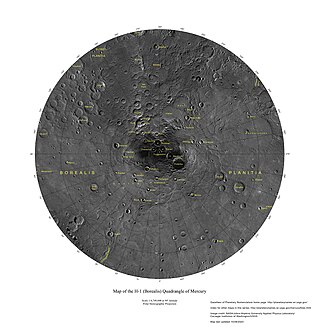
The Borealis quadrangle is a quadrangle on Mercury surrounding the north pole down to 65° latitude. It was mapped in its entirety by the MESSENGER spacecraft, which orbited the planet from 2008 to 2015, excluding areas of permanent shadow near the north pole. Only approximately 25% of the quadrangle was imaged by the Mariner 10 spacecraft during its flybys in 1974 and 1975. The quadrangle is now called H-1.
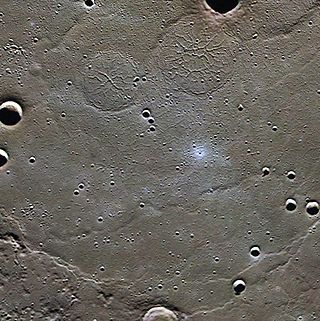
Goethe Basin is an impact basin at 81.4° N, 54.3° W on Mercury approximately 317 kilometers in diameter. It is named after German poet Johann Wolfgang von Goethe.

The Tolstoj quadrangle in the equatorial region of Mercury runs from 144 to 216° longitude and -25 to 25° latitude. It was provisionally called "Tir", but renamed after Leo Tolstoy by the International Astronomical Union in 1976. Also called Phaethontias.
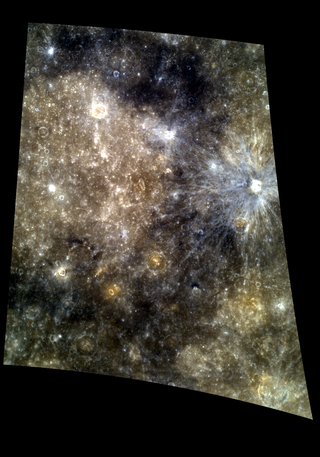
Tolstoj is a large, ancient impact crater on Mercury. It was named after Leo Tolstoy by the IAU in 1976. The albedo feature Solitudo Maiae appears to be associated with this crater.

The Shakespeare quadrangle is a region of Mercury running from 90 to 180° longitude and 20 to 70° latitude. It is also called Caduceata.

The Beethoven quadrangle is located in the equatorial region of Mercury, in the center of the area imaged by Mariner 10. Most pictures of the quadrangle were obtained at high sun angles as the Mariner 10 spacecraft receded from the planet. Geologic map units are described and classified on the basis of morphology, texture, and albedo, and they are assigned relative ages based on stratigraphic relations and on visual comparisons of the density of superposed craters. Crater ages are established by relative freshness of appearance, as indicated by topographic sharpness of their rim crests and degree of preservation of interior and exterior features such as crater floors, walls, and ejecta aprons. Generally, topography appears highly subdued because of the sun angle, and boundaries between map units are not clearly defined.

The Eminescu quadrangle (H-9) is one of fifteen quadrangles on Mercury. It runs from 216 to 288° longitude and from -25 to 25° latitude. Named after the Eminescu crater, it was mapped in detail for the first time after MESSENGER entered orbit around Mercury in 2011. It had not been mapped prior to that point because it was one of the six quadrangles that was not illuminated when Mariner 10 made its flybys in 1974 and 1975. These six quadrangles continued to be known by their albedo feature names, with this one known as the Solitudo Criophori quadrangle.

The Neruda quadrangle (H-13) is one of fifteen quadrangles on Mercury. It runs from 180 to 270° longitude and -20 to -70° latitude. Named after the Neruda crater, it was mapped in detail for the first time after MESSENGER entered orbit around Mercury in 2011. It had not been mapped prior to that point because it was one of the six quadrangles that was not illuminated when Mariner 10 made its flybys in 1974 and 1975. These six quadrangles continued to be known by their albedo feature names, with this one known as the Solitudo Persephones quadrangle.

The Michelangelo quadrangle is in the southern hemisphere of the planet Mercury, where the imaged part is heavily cratered terrain that has been strongly influenced by the presence of multiring basins. At least four such basins, now nearly obliterated, have largely controlled the distribution of plains materials and structural trends in the map area. Many craters, interpreted to be of impact origin, display a spectrum of modification styles and degradation states. The interaction between basins, craters, and plains in this quadrangle provides important clues to geologic processes that have formed the morphology of the mercurian surface.

Bashō is a crater on Mercury named after Matsuo Bashō, a 17th-century Japanese writer. Bashō crater is only 74.62 kilometers (46.37 mi) in diameter, but is a prominent feature on Mercury's surface, due to its bright rays. Photographs from NASA's Mariner 10 and MESSENGER spacecraft show a curious halo of dark material around the crater.
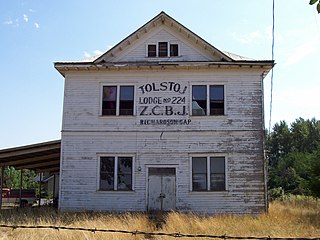
The Z.C.B.J. Tolstoj Lodge No. 224, also known as Bohemian Hall or Tolstoj Sokol Lodge, is a historic building in rural Linn County southeast of Scio, Oregon, United States, that was built in 1911. It was listed on the National Register of Historic Places on September 14, 1995. It historically served as a meeting hall for the Czech community. The lodge organized a Czech school, in addition to hosting concerts, dances, Sokol events and Fourth of July celebrations.

Eitoku is a crater on Mercury. It has a diameter of 101 kilometers. Its name was adopted by the International Astronomical Union in 1976. Eitoku is named for the Japanese artist Kanō Eitoku, who lived from 1543 to 1590.

Kālidāsā is a crater on Mercury. Its name was adopted by the International Astronomical Union in 1976. Kalidasa is named for the Indian writer Kālidāsa, who lived in the 5th century CE.
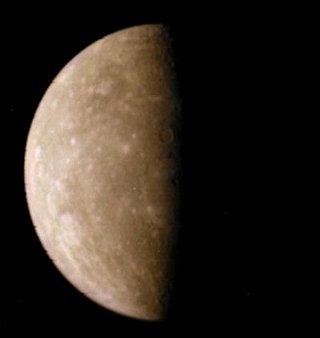
Pre-Tolstojan, also Pretolstojan Period, refers to the oldest period of the history of Mercury, 4500–3900 MYA. It is the "first period of the Eomercurian Era and of the Mercurian Eon, as well as being the first period in Mercury's geologic history", and refers to its formation and the 600 million or so years in its aftermath. Mercury was formed with a tiny crust, mantle, and a giant core and as it evolved it faced heavy bombardments that created most of the craters and intercrater plains seen on the planet's surface today. Many of the smaller basins and multi-ring basins were created during this period. Considered a "dead" planet, its geology is highly diverse with craters forming the dominant terrain.

Vālmiki is a crater on Mercury. Its name was adopted by the International Astronomical Union (IAU) in 1976. It is named for the Indian poet Valmiki.
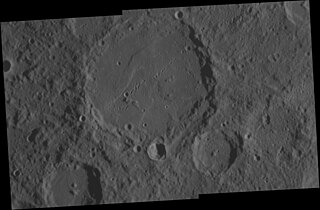
Rublev is a crater on Mercury. Its name was adopted by the International Astronomical Union (IAU) in 1976. Rublev is named for the Russian painter Andrei Rublev.





















